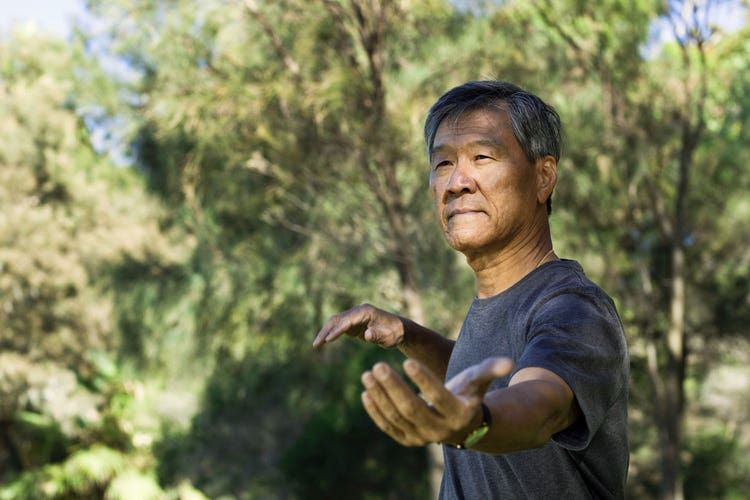Tap Into Your Reserves

Get back in touch—literally—and find your body and mind’s hidden strength.
One of the most beneficial (and necessary) things you can do for your own self-care and personal perseverance is spend time with your attention turned inward—attune to your inner world.
We live in an extremely externally oriented society. The majority of us spend most of our time with our awareness anchored on the world outside ourselves (reading, watching, scrolling, working, creating, listening, driving, etc.), paying little to no attention to the dynamic landscape of sensations, feelings and emotions that make up our rich internal worlds. Yet it’s our internal worlds that dictate so much of our experiences despite our external circumstances. For as much time as we spend outwardly focused, it’s worth spending at least some time becoming familiar with our inner terrain.
Mindfulness expressed in the body

Interoception is internal bodily awareness, the capacity to attend to the many sensations taking place on the inside. In other words, it relates to paying attention to your inner experience as it changes moment to moment. Proprioception is the ability to sense your body in space. It refers to knowing where your right hand and left foot are as they move through space versus being aware of the bodily sensations, feelings and emotions fluctuating internally (interoception).
While a lot of us, especially performers and athletes, have honed our proprioception, not as much attention has been paid to the development of our interoception. We can dance, bike, surf, kick box and do all kinds of incredible activities with our bodies—it’s being still, free of external distractions, and turning inward that most of us avoid doing at all costs. This is partly because we live in a society overloaded with external sensory distractions (and don’t place as much value on our internal experiences) and in part because turning inward, and facing what comes up, isn’t always comfortable. At the very least, our internal worlds are not nearly as familiar to us as our external ones.
Turning inward can seem scary at first, even distressing. If you haven’t checked in lately, chances are you will be confronted with difficult emotions that have been stored away. But as uncomfortable as it is, they deserve and need your attention to be processed and healed, or they will continue to reside just beneath the surface, helping dictate your unconscious experience. Being present with your emotions, feelings, memories and sensations without evaluating or attaching to them—holding them in pure and loving awareness as they arise—is an essential part of the healing process.
At home in the wilderness

Researcher, clinical psychologist and renowned yoga therapist Bo Forbes describes interoception as entering the “wilderness of the body,” which by its nature is scary, unpredictable and always changing (much like your emotional states and experiences). Each time you enter and visit for a bit, you become more and more familiar with the changing terrain of your inner world—until entering the wilderness of your body feels like home.
Every time you turn inward, you put another penny in the piggy bank, building a reserve. When you are able to be completely at ease with entering the great unknown of your inner terrain, you develop a sense that you can handle the unpredictable and don’t have to be completely carried away, or caught off guard, by your emotional reactions. You develop a body-based resiliency that becomes a foundation for emotional resiliency.
The more at home you are in the wilderness of your body, the more resilient you become.
Where to begin

We are constantly being stimulated by our external environments, which keeps our nervous systems on high alert in a near continual state of fight-or-flight that begins to wear us down not only physically but also mentally and emotionally. To do, be and feel our best, we must take time to allow our nervous systems to rest.
Enter the practice of “pratyahara,” or “withdrawing the senses.” We receive information from the world around us through our five main sense organs; withdrawing our senses from external stimulus gives our nervous systems a chance to unwind and our inner worlds to be heard. Practicing pratyahara is one of the first steps toward developing more interoceptive awareness.
There are many ways to practice pratyahara, one of which is to simply close your eyes and pay attention to the sensations of your breath as it moves in and out of your body. However, I’ve found that certain restorative yoga positions, like the one below, are extremely helpful for turning inward. Having the front of the body down is particularly helpful for withdrawing the senses, feeling safe and calming the mind, allowing your nervous system to rest and replenishing your internal resources.
One last note: Turning your awareness inward is a profound act of self-love, signaling to all aspects of your being that you matter, that you are worthy of your own precious attention. Just being with yourself, in your body, allowing and accepting whatever arises can be a deeply (albeit painful) healing experience.
Try it: Pratyahara practice (in a restorative yoga position)

What you’ll need: 2 or 3 long, rectangular folded blankets; 1 rolled blanket; 1 small rolled towel; and a quiet room
Set up: Stack your long, rectangular folded blankets, slightly staggering them like a staircase going up. Fold the far edge of the top blanket back toward you, about two-thirds of the way (where you will place your rib cage and chest). Place your small rolled towel at the top of your stacked blankets (where you will place your forehead), and place a rolled blanket on the floor behind the stacked blankets (where your feet will rest).
Get into position: Essentially you will be lying face down on your stack of long, rectangular folded blankets like it’s a surfboard with your forehead resting on your small blanket roll and your feet and ankles supported by your rolled blanket. From all fours, lower your torso onto the stacked blankets, bringing the tops of your thighs onto the blanket stack so your pelvis is resting on the blankets and placing your chest onto the extra blanket fold so your rib cage is supported. Place the tops of your feet on the blanket roll, resting your knees on the floor, and lay your forehead on the towel roll (which you may have to adjust for a comfortable neck position).
Make any adjustments necessary to feel more comfortable before relaxing into the pose. Lightly close your eyes and deepen your breath, releasing all your weight onto the blankets. Follow your breath inward. Feel your breath and notice any sensations taking place. Try to let go of any preconceived notions of what you might find, and do your best to stay present to whatever arises without self-evaluating or needing to do anything about it.
If you happen to doze off or check out, don’t stress about it. You must have needed the rest. When you’re ready to be done, take a few deeper breaths and lightly tap your fingertips on the floor. Then slide your hands underneath your shoulders, gently press yourself back up to all fours and slowly make your way into a seated position. Take a few breaths and notice how you feel.
Photo credit: Jupiterimages, Thinkstock; PointImages, Adobe Stock; vovik_mar, Thinkstock; arthurhidden, Adobe Stock; Julie, Adobe Stock